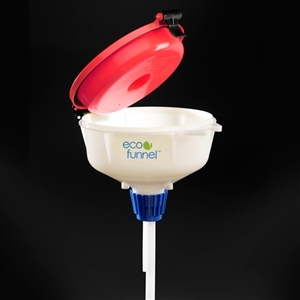ECO Funnel FAQ
 What are ECO Funnels® made of?
What are ECO Funnels® made of?
They are made out of High Density Polyethylene (HDPE).
(See our Chemical Chart)
Do ECO Funnels® resist solvents? Common laboratory solvents such as acetone, hexane, acetonitrile, etc.are fine to use with the ECO Funnel®, as are most other chemical solvents.
I use a 1 Gallon amber glass bottle to collect waste. Is there an ECO Funnel® that I could purchase separately to use with my 1 Gallon bottle? And what is the cap size?
Yes, any ECO Funnel® with a 38-430 closure will work.
They come either in 8" (EF-3004C) or 4" ( EF-4-38) top diameter. However, be careful using our funnel with glass. Over tightening on glass screw threads can cause the screw cap to disconnect from the funnel body.
Do you have an ECO Funnel® available for a 5 Gallon stackable carboy, or a 30 or 55 Gallon Drum?
Yes, custom funnels with special adapters (to fit most containers) can be special ordered from us.
Does the ECO Funnel® comply with regulations for emissions from open waste containers?
Yes. The primary function of the ECO Funnel is to reduce the emission of volatile solvents to near zero, while providing a convenient way to handle temporary waste in the lab.
Are there any chemicals that should be avoided when using the ECO Funnel®?
Yes, you should avoid strong acids, bases and oxidizers that can jeopardize HDPE.
Can the ECO Funnel® be kept on the waste bottle 24 hrs a day?
We recommend that the ECO Funnel be removed from a waste container when not in use, just like any other funnel. They are for the collection of temporary waste only. Waste should be frequently transferred to a more permanent waste container for optimum safety.
What about Pressure build-up inside the waste bottle?
Under normal circumstances, pressure inside a bottle is released through the pressure relief tube molded into all ECO Funnels. Additionally, when the funnel lid is latched and closed, slight pressure can be released through use of 1 or more Vent Filters, which can be custom fitted to your ECO Funnel and utilize a glass micro fiber filter to catch emissions as it releases air through the funnel side wall.
When using with HPLC applications that result in slow pressure build up inside the closed ECO Funnel, CP Lab Safety recommends adding 1 Vent Filter (VF-201) for every one or two HPLC lines attached to a Safety ECO Funnel®.
How should I clean my ECO Funnel?
If you need to clean your funnel, we recommend using a wash bottle full of acetone. Rinse the funnel three times with acetone, and then three times with water to ensure no residue remains.
Have a favorite bottle that I use for collecting waste. Can you make an ECO Funnel® for my bottle?
Yes, they can be special ordered on a custom project basis. Customer must provide enough information about the containers or a sample of the container with the cap. A price quote will be provided, or you can call us at (888) 322-5722 for immediate assistance.
How long do ECO Funnels last?
ECO Funnels are very durable and long-lasting. The various parts of the funnel (body, lid, screw cap, tubes, gaskets) are made from HDPE, polypropylene and Viton, and resist most chemical damage. However, plastics degrade over time and with exposure to chemicals. Based on typical usage in a lab, some of the the plastic parts will lose their integrity after approximately 2 years, and the funnel should be replaced.
Please note: The end user is responsible for knowing the compatibility of the chemicals they are using. Check with the chemical manufacturer for more information about compatibility with HDPE. All wetted parts of ECO Funnel are made from HDPE.
